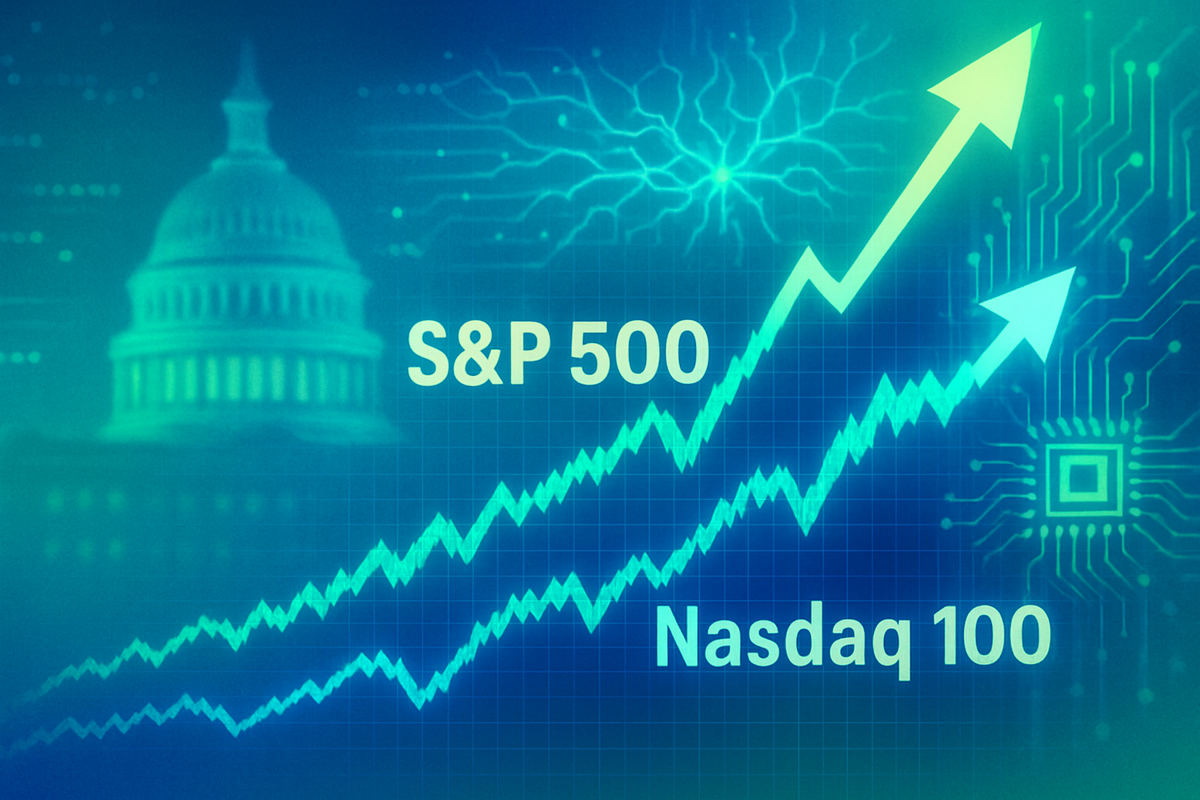
New York, October 3, 2025 – In a remarkable display of market resilience, both the S&P 500 and Nasdaq 100 indices have soared to new record highs, largely defying the commencement of a United States government shutdown on October 1, 2025. This unexpected surge underscores a powerful underlying current of investor optimism, primarily fueled by the relentless growth in artificial intelligence and strong expectations for further interest rate cuts by the Federal Reserve. As political gridlock once again grips Washington, financial markets appear to be looking beyond the immediate headlines, prioritizing robust economic fundamentals and technological advancements.
The current market sentiment suggests a growing detachment between short-term political uncertainties and the long-term growth trajectory of the private sector, particularly in high-innovation areas. This defiance, while a testament to the strength of certain economic drivers, also highlights a nuanced environment where specific sectors and companies face distinct challenges, even as the broader market thrives. Investors are navigating a complex landscape where discerning genuine innovation from speculative fervor, while monitoring political developments, remains paramount.
Market Defiance: A Deep Dive into the Current Rally
As of October 3, 2025, the S&P 500 closed at an all-time high of 6,715.35, extending an impressive run that included a 3.5% surge in September and marking its fifth consecutive monthly gain. Year-to-date, the index is up close to 14%. Similarly, the tech-heavy Nasdaq Composite advanced to 22,844.05, also reaching a record closing high, with the Nasdaq 100 surging to its second consecutive record. This robust performance is particularly striking given the backdrop of a government shutdown, the first in seven years, which typically introduces a degree of market uncertainty.
The market's ability to "shrug off" the political impasse is multifaceted. Historically, U.S. government shutdowns have had a relatively muted and temporary effect on the economy and financial markets, with investors often viewing them as short-lived political theater. This time, however, the market's resilience is amplified by several key drivers. Robust corporate earnings have been a significant catalyst, with companies demonstrating strong financial health. Furthermore, strong expectations for further interest rate cuts by the Federal Reserve are fueling market gains, with investors widely anticipating a quarter-point rate cut at the central bank's October 28-29 meeting, solidified by a soft Automatic Data Processing (ADP) employment report showing a decline of 32,000 in private payrolls for September.
Perhaps the most potent force underpinning the current rally is the continued excitement and secular growth theme surrounding Artificial Intelligence (AI). The AI spending boom is so powerful that it is overriding concerns about the government shutdown on broader equity markets, even in Europe and Asia. While initial volatility is common during shutdown announcements, experienced traders often view this period as presenting tactical opportunities rather than long-term threats, as markets tend to look beyond temporary political disruptions, focusing on the long-term outlook.
Winners and Losers: Companies Navigating the Current Climate
The current market environment, characterized by AI-driven growth, anticipated interest rate cuts, and a government shutdown, creates a clear bifurcation of winners and losers among public companies.
Companies Poised to Win:
The Artificial Intelligence (AI) revolution remains the most significant tailwind. Companies at the forefront of AI development and infrastructure are experiencing substantial gains:
- Nvidia Corp. (NASDAQ: NVDA), a leader in AI-crucial GPUs, continues its impressive run, up 40.8% year-to-date.
- Microsoft Corp. (NASDAQ: MSFT), a major hyperscaler with massive AI infrastructure investments, has seen its shares rise 22.5% year-to-date.
- Alphabet Inc. (NASDAQ: GOOG, GOOGL), Google's parent company, is also heavily investing in AI, with shares up 28.6% year-to-date.
- Broadcom Inc. (NASDAQ: AVGO) is a major contributor to the S&P 500's rally, with AI product revenue expected to reach $12 billion by year-end.
- Oracle Corp. (NYSE: ORCL), with significant cloud growth, recently secured a substantial cloud-computing deal with OpenAI.
- Palantir Technologies Inc. (NYSE: PLTR) is seeing robust demand for its AI Platform (AIP) from both commercial and government sectors.
- Other notable AI beneficiaries include AppLovin (NASDAQ: APP), Adobe (NASDAQ: ADBE), Advanced Micro Devices (NASDAQ: AMD), ASML Holding N.V. (NASDAQ: ASML), Arista Networks, Inc. (NYSE: ANET), and Elastic N.V. (NYSE: ESTC).
Anticipated Interest Rate Cuts by the Federal Reserve are also creating winners, generally favoring growth stocks, real estate, and financials:
- Technology and Consumer Discretionary (Growth and Small-Cap Stocks) are highly sensitive to reduced borrowing costs.
- Financials, including major banks like Goldman Sachs Group Inc. (NYSE: GS) and regional banks like First Horizon National Corporation (NYSE: FHN), benefit from stimulated lending activity. Tiger Brokers (NASDAQ: TIGR) may also see increased trading.
- Real Estate, including REITs like Prologis, Inc. (NYSE: PLD) and Host Hotels & Resorts, Inc. (NASDAQ: HST), and homebuilders, benefit from lower financing costs and increased affordability. Suppliers like Builders FirstSource, Inc. (NASDAQ: BLDR) and Mohawk Industries, Inc. (NYSE: MHK) are also poised to gain.
- Capital-intensive sectors like Utilities (e.g., NextEra Energy (NYSE: NEE)) and Telecommunications (e.g., AT&T (NYSE: T)) see reduced debt servicing costs.
Companies Potentially Negatively Impacted:
Despite the broad market's resilience, the government shutdown creates specific vulnerabilities:
- Government Contractors face immediate risks of payment delays and project disruptions. This includes Northrop Grumman Corp. (NYSE: NOC), Lockheed Martin Corp. (NYSE: LMT), and The Boeing Company (NYSE: BA), which have already seen share price declines.
- Healthcare Companies reliant on federal programs, especially those tied to Medicare and Medicaid, may experience volatility.
- Industries Requiring Regulatory Approvals are significantly affected as agencies like the SEC, FDA, and EPA operate with minimal staff. This slows down crucial approvals for new products, IPOs, drug trials, environmental permits, and M&A, impacting biotech, energy, and financial services sectors. Exporters of defense articles also face delays from the Directorate of Defense Trade Controls (DDTC).
- Companies Relying on Timely Economic Data suffer from the "economic data blackout," which increases uncertainty for investors and complicates the Federal Reserve's policy decisions.
Wider Significance: A Market Transformed by Tech and Policy
The S&P 500 and Nasdaq 100's defiance of the current government shutdown in October 2025 signals a significant evolution in market dynamics. This resilience suggests that investors are increasingly prioritizing fundamental economic drivers and technological advancements over short-term political discord, viewing government shutdowns as transient political events rather than systemic economic threats. This phenomenon underscores a growing disconnect between Washington's political gridlock and the robust performance of the private sector, particularly in high-growth areas.
This event fits squarely into two overarching industry trends: the explosive growth of Artificial Intelligence and the anticipated dovish shift in monetary policy. The AI boom, driven by massive investments in data centers and AI infrastructure, continues to fuel investor enthusiasm and capital flows into tech giants. News of significant AI deals, such as OpenAI's rising valuation and partnerships with South Korean chipmakers, directly contributes to the rally in technology stocks. Simultaneously, expectations of Federal Reserve interest rate cuts are buoying markets, despite the shutdown delaying crucial economic data releases. Markets are largely pricing in a high probability of further rate cuts, believing that a dovish Fed will continue to support economic activity and corporate earnings.
However, this market resilience masks significant ripple effects. Government contractors and small businesses heavily reliant on federal contracts face immediate risks of payment delays and project disruptions, threatening their liquidity and workforce stability. The tech sector, while leading gains, faces disruptions like halted H-1B visa processing, impacting startups reliant on skilled immigrant workers. Regulatory bodies like the FCC and NTIA have curtailed operations, slowing crucial digital infrastructure rollouts. The healthcare sector could also face volatility if Affordable Care Act (ACA) tax credits, set to expire at year-end, are not extended.
Regulatory and policy implications are substantial. The reduced operations of agencies like the FDA and SEC lead to delays in approvals and oversight, affecting pharmaceutical, biotech, and financial firms. The "data blackout" from suspended economic releases creates uncertainty for both investors and the Federal Reserve, complicating monetary policy decisions. Uniquely, the current administration's threat of permanent federal worker layoffs, rather than temporary furloughs, could have a more significant and lasting impact on government capacity and efficiency than previous shutdowns. Historically, the S&P 500 has shown mixed to minimal lasting impact from shutdowns, often recovering quickly. For example, during the 2013 shutdown, the S&P 500 advanced 3.1%, and during the longest shutdown (2018-2019), it eventually posted positive returns. However, the current blend of powerful AI tailwinds, dovish monetary policy expectations, and the unusual threat of permanent job cuts distinguishes this event from past precedents.
What Comes Next: Navigating the Evolving Landscape
The path forward for global markets, with the S&P 500 and Nasdaq 100 demonstrating resilience amidst a government shutdown, hinges critically on the duration and nature of this political impasse. While historical patterns suggest a limited and temporary impact, the unique confluence of AI-driven growth and anticipated monetary policy shifts introduces new dynamics.
In the short-term, if the shutdown is brief (e.g., less than 1-2 weeks), initial market volatility is likely to subside quickly. The S&P 500 and Nasdaq 100 would likely resume their upward trajectory, buoyed by strong corporate fundamentals and expectations of Fed rate cuts. However, sector-specific impacts will persist, with government contractors facing payment delays and industries requiring regulatory approvals experiencing ongoing slowdowns. The "economic data blackout" will continue to complicate the Federal Reserve's decision-making process. The U.S. dollar may continue to weaken, while safe-haven assets like gold could see sustained demand.
For the long-term, the outlook is more nuanced. If shutdowns remain short-lived and infrequent, the underlying strength of corporate earnings and technological advancements, particularly in AI, could continue to drive sustained market growth. However, prolonged or increasingly frequent shutdowns could erode public and investor trust, create significant uncertainty, and hinder long-term economic planning. This could lead to businesses becoming hesitant to invest in projects reliant on federal stability, and international investors potentially reallocating away from U.S. assets. A prolonged shutdown involving permanent federal worker layoffs, a departure from historical norms, could have a more severe and lasting impact on the labor market and broader GDP.
Strategic pivots and adaptations will be crucial for businesses and investors. Businesses, especially federal contractors, must develop robust scenario plans, diversify their customer bases, and strengthen cash flow management to withstand potential payment delays. Workforce management strategies, including clear furlough policies or preparedness for potential layoffs, will be vital. Investors should prioritize diversification across asset classes, sectors (including defensive stocks), and geographies. A focus on quality companies with strong fundamentals, a long-term perspective, and an openness to opportunistic buying during market dips will be key. Active management may also prove advantageous in navigating increased volatility.
Market opportunities could emerge from undervalued assets during shutdown-induced corrections, continued demand for safe-haven assets, and the resilient performance of defensive sectors. The relentless innovation in AI and tech will remain a significant growth driver. Conversely, challenges include heightened market volatility, the uncertainty caused by the economic data blackout, potential erosion of consumer and business confidence, and global spillover effects from U.S. political instability. Geopolitical risks will also continue to add layers of complexity.
Potential scenarios range from a quick resolution with minimal lasting impact, allowing markets to continue their ascent, to a prolonged shutdown leading to more significant economic drag and sustained market corrections. A third, more concerning scenario involves repeated shutdowns and persistent political dysfunction, which could structurally weaken confidence in U.S. governance, lead to capital flight, and fundamentally alter global market dynamics.
Wrap-Up: A Resilient Market in Uncertain Times
The current market performance, where the S&P 500 and Nasdaq 100 are defying a government shutdown, is a testament to the powerful underlying forces shaping today's financial landscape. The relentless innovation in Artificial Intelligence, coupled with strong expectations for accommodative monetary policy from the Federal Reserve, is creating a formidable tailwind that, for now, is overshadowing political discord. Investors are demonstrating a mature approach, looking beyond short-term political noise to focus on corporate fundamentals and secular growth trends.
Moving forward, the market's resilience will likely be tested by the duration and frequency of government shutdowns. While historical data suggests markets tend to recover swiftly, the unique threat of permanent federal job cuts in this instance adds a new layer of uncertainty. Businesses must fortify their operations against potential disruptions, while investors should prioritize diversified, fundamentally sound portfolios with a long-term perspective.
The lasting impact of this period will depend on whether political instability becomes a persistent feature or remains a transient event. What is clear is that the market is increasingly driven by technological innovation and global economic factors, demonstrating a remarkable ability to push past domestic political headwinds. Investors should closely watch for any signs of a prolonged shutdown, the Federal Reserve's response to the data blackout, and the continued pace of AI development, as these will be critical determinants of market direction in the coming months.
This content is intended for informational purposes only and is not financial advice.







